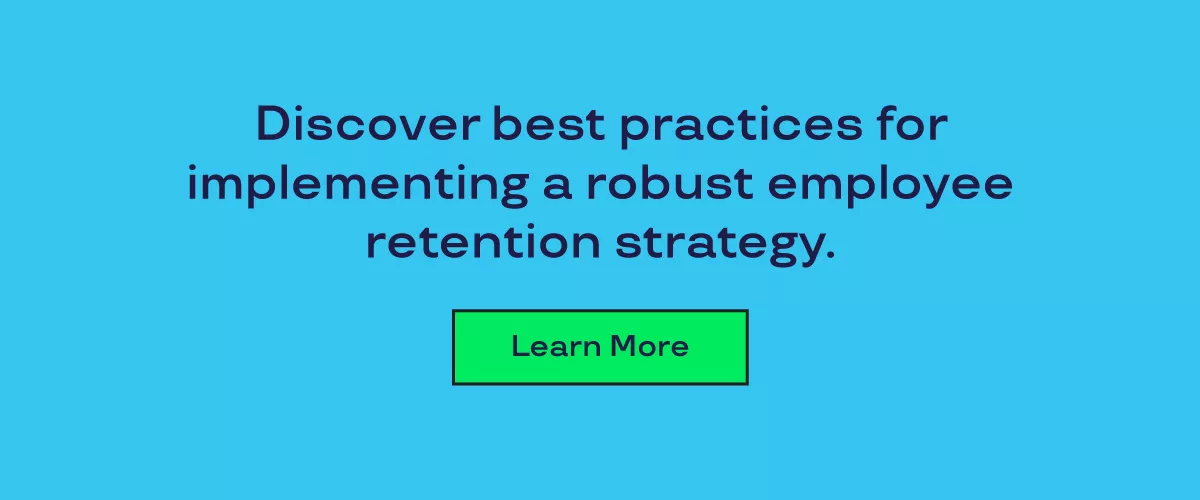
The Key Elements of Employee Retention Success
December 21, 2023
Understanding the elements of employee retention, how to influence the contributing factors, and the most effective strategies for improving the conditions that make better outcomes probable and not just possible.
We’ve identified 10 core elements for retaining employees. Mastering these fundamental keys to employee retention gives organizations the best chance at success, and can help improve long-term outcomes.
Key Element #1: Competitive Compensation and Benefits
Among the most obvious components of employee retention are competitive compensation and benefits. Without these essential elements, organizations are hard-pressed to move the needle on the other factors that contribute to employee retention. Maintaining competitive compensation and benefit offerings deserves its spot at the top of the list of employee retention strategies.
Earning competitive compensation and enjoying employee benefits both contribute to employees’ day-to-day well-being and impact their everyday work experience. If employees feel they are struggling financially or do not have access to benefits they need to care for their mental and physical health, employee engagement can suffer, motivating people to start looking elsewhere to meet their needs. Offering comprehensive (and relevant) health benefits, retirement savings plans, and additional paid time off can all help employees meet their needs without leaving the organization.
Together, compensation and benefits are the cornerstones of employee engagement and retention, and a necessary first step in finding employee retention success.
Key Element #2: Opportunities for Career Growth
The next crucially important step for effective staff retention is the opportunity to grow and learn. Offering professional development and skills training is linked with higher levels of employee engagement, a key driver of retention. When organizations offer training and development programs, in conjunction with meaningful career advancement paths, employees may be more likely to feel their employer is truly invested in their individual success.
Creating clear career paths within the organization and supporting advancement through mentorships and skills training can help employees envision a future within the organization—and give them roadmaps to follow depending on their goals.
Key Element #3: Positive Work Environment and Company Culture
Next in our list of essential elements of employee retention is a healthy work culture. Organizations with toxic culture tend to struggle with workforce retention, while those with a positive work environment actively foster employee retention.
While this is one of the less tangible elements for retaining talent, the importance of work culture cannot be understated. One of the most effective ways to create a more supportive and inclusive workplace is to allow and encourage people to voice their ideas without fear of ridicule or negative repercussions. In work cultures that embody the idea that there are no bad ideas or silly questions, people may feel more comfortable sharing their thoughts, enabling more productive brainstorming and troubleshooting on a day-to-day basis.
Key Element #4: Recognition and Appreciation
Recognition and appreciation—especially when baked into organizational culture—are two often-overlooked secrets to employee loyalty and retention. Having proactive strategies and effective tools for recognizing and appreciating employees’ contributions, efforts, and milestones is necessary; these things don’t happen by accident.
In recent years, data around reasons that employees quit their jobs often reveals a link between the decision to leave and the level of recognition they experienced. Conversely, employees who receive regular recognition and appreciation—whether through formal channels or in one-on-one conversations with their team leader—tend to also report higher levels of engagement and job satisfaction.
Key Element #5: Work-Life Balance
Work-life balance is a driving force that shapes the everyday experience for employees at all levels of an organization. If employees feel their job doesn’t allow a good balance or that work-related stress is too high, it makes perfect sense that they might look for other employment opportunities.
Proactively supporting work-life balance is one of the foundational elements for reducing employee turnover. Offering flexible work arrangements—such as remote and hybrid work or flexible shift hours—can contribute to better retention levels. But policy alone can’t ensure work-life balance. Organizational culture must allow for it, also. This is often reflected in organizations by avoiding or even prohibiting early morning and late afternoon meetings, reviewing workloads periodically, and encouraging time off.
Key Element #6: Effective Communication
Another key contributor to long-term staff retention is clear and effective communication—and not just from leaders to the rest of the workforce, but the reverse as well. Organizations that foster open and transparent communication often see higher levels of employee engagement, boosts in productivity, and reduced turnover.
Two-way communication is crucial to creating a culture where employees feel seen and heard. We’ve observed that organizations with better retention typically employ proactive channels for employees to voice concerns or ideas, such as anonymous employee feedback surveys and tools that give leaders real-time access to the pulse of the workforce.
Key Element #7: Managerial Support and Leadership
If an organization’s managers are struggling, the odds of employees being happy and successful is understandably lowered. Even before the COVID-19 pandemic, employees who voluntarily quit their jobs often reported that their boss was a key reason for their decision. On the flip side, great managers give employees more reasons to stay.
When creating policies and programs to improve retention, it’s essential to investigate the challenges and experiences managers are facing. Managers and other leaders are employees, too, and they deserve support, work-life balance, and learning opportunities. The first step to better supporting managers is asking them what they need. Conducting skill assessments to identify opportunities for professional development—especially in the soft skills necessary for effective leadership—is another common strategy. When managers and leaders are strong and capable, organizational culture tends to thrive, which keeps employees engaged and protects against turnover.
Key Element #8: Employee Involvement and Engagement
As we’ve suggested already, the more engaged employees are, the less likely they will be to consider quitting. Creating a work experience and environment that makes engagement possible is the first phase. The next is actively involving employees in activities that boost engagement.
An easy access point into this kind of employee engagement strategy is inviting employees to participate in decision-making processes. Asking people for their input and suggestions helps them feel valued; acting on that feedback enhances that feeling exponentially. On an individual level, organizations can foster engagement and empower employees by asking them to write a description of their role, which can be used to evaluate and update the original job description. Creating opportunities for alignment within an employee’s role, immediate team, department, and across the organization can all help improve retention.
Key Element #9: Employee Well-Being and Health
Physical and mental health play a major role in employee well-being, and thus have an impact on retention. Along with the work-life balance discussion above, organizations need to offer comprehensive benefits, wellness programs and other resources to help employees take care of themselves and their families. Doing so helps companies better compete for top talent—wellness benefits are among the most highly sought after—as well as retain employees, for the same reasons.
Effective strategies for promoting employee health include coverage for mental health care, flexible spending accounts, memberships and reimbursements for a range of fitness and wellness programs, flexible PTO policies, regular paid ‘wellness days’ off, and even company-wide shutdowns specifically for the purpose of rest.
Key Element #10: Flexibility and Adaptability
Perhaps above all else, organizations need to be flexible and adaptable to retain employees. New challenges and needs arise practically every day, and organizations that cannot quickly pivot will almost certainly suffer. The changing nature of work has, over the past few years, shown us many examples of this. And the impact on retention is clear, too.
Tying It All Together
Applying these key principles for employee retention success helps organizations improve the everyday employee experience, boost engagement, and differentiate from other employers. The end result, over time, is a positive impact on employee retention. With lower turnover comes the obvious cost savings (from not having to hire to backfill as many positions) as well as a reduction in disruptions in productivity and innovation.
Using this list of key elements of employee retention as a guide, take some time to evaluate your current retention strategies and identify opportunities to enhance your approach to steer in the direction of your goals.





